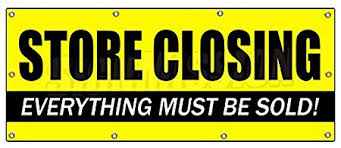Do you know why in the United States there are so many retail business failures? “In the United States alone, on average 1 retailer failed every 12 minutes. Five failures per hour, 24 hours per day, 365 days per year. ” That’s the findings of The Retail Store Owners Institute.
They published an article, “Why Retailers Fail”, that is worth reading. It explains the top five reasons for retail business failures.
Retail Business “Killer” #5: Out-of-Control Balance Sheet
If you are considering expansion into new lines, new departments or new locations, you must not ignore the management of your Balance Sheet. Expansion is successful only when your balance sheet gets stronger.
What is your debt-to-worth ratio now? What will it be a year or two from now? Growth will be an affordable option only when it is the result of careful financial planning.
Growth of any kind means an increase in assets, which can be purchased either with excess profits or an increase in debt. Projecting those changes will get a projected debt-to-worth ratio, the best measurement of financial strength that exists. (Note: If you must shrink your business, the same ratio should be your guide.) Not watching your balance sheet is a key reason for many retail business failures.
Retail Business Killer #4: Out-of-Control Expenses
Productivity. Making each dollar count. Getting the greatest return on each dollar spent. Yes, we’re talking about expense management—the #4 killer of retail businesses. Expense management may sound like an old idea, but today, it’s more important than ever. Ignore it at your business’ risk!
In retailing, your major expenses may seem fixed (i.e., premises, permanent staff salaries, etc.) These costs must be covered by margin dollars, whether sales are strong or weak. But there are areas in your business with variable expenses where you likely can cut costs.
Be creative! Ask your staff for help on cost-saving ideas. Put special attention on “the creepers”; what a menace those are!
Budgeting, of course, will be your main tool for keeping expenses down. A pro forma (projected) Income Statement is a necessity. You must forecast expenses and adhere to budget guidelines to keep from retail business failures. Then tie that discipline to dealing with the #3 killer: Gross Margin.
Retail Business Killer #3: Failing to Manage Gross Margin
The #3 “killer” of retail business is inadequate gross margin management. As a retailer, you must not ignore the message of your gross margin. Don’t ask, “How are my sales?” but rather, the more important question, “How are my Gross Margin dollars contributing to operating profit?” By department, by vendor, even by SKU, what are the trends? And what are my options?
As a general rule in retailing today, Gross Margins are dropping. (Just take a moment to look at the Gross Margin trends of the 55 Retail Segments found in Store Benchmarks here on The ROI site.) This is caused by the largest retailers incessantly cutting their operating expenses, then lowering their needed margins so they can lower their retail prices and better compete with the other retail monsters. Sadly, many independent retailers get caught in this spiral. You must not!
Specialty retailers who remain “special” can actually raise their margins in many cases. The key is, “Better buying for your better customers.”
Another key to managing Gross Margin is using a tool called GMROI – Gross Margin Return on (Inventory) Investment – to compare departments, lines, or products. GMROI should be in every retailer’s arsenal. Take a year’s gross margin dollars for a particular line of product and divide by the average cost value of inventory in that product line. Compare this dollar return with other product lines.
Retail Business Killer #2: Out-of-Control Inventory
All retail businesses that carry inventory have special problems. Inventory is the “engine” of the business; it generates all of the Gross Margin dollars and it is responsible for customer satisfaction (or the lack of it.) But inventory also soaks up cash, often lots of it.
Inventory has one more unique feature: the pressures to buy more and more of it. Just think about this: pressures to buy more  and/or different stock come from…
and/or different stock come from…
• your own well-intended sales associates
• current and new vendors
• offering what a competitor is carrying
• customers asking for new or different items
• and of course, from a disgruntled sometime customer you run into at a neighbor’s party!
How to offset all this pressure to over-buy or buy the wrong thing? The pros always budget their inventory buying with an Open-to-Buy system set up by department or classification or by store. Then, they follow the budget! The real pros in retailing respect their OTB plan as highly as any responsibility they have.
The #1 Killer of Retail Businesses: Being Out of Cash
“Profit cures a lot of ills, but cash flow pays the banker’s bills.” Poor cash management is the #1 killer of retail businesses today. Producing profits may be the sign of a good business, but profits matter little if a business runs out of cash. What keeps retail
businesses running is enough cash coming in so that purchases can be made and obligations met at all times. Poor cash management is the leading cause of retail business failures!
Mismanaging cash can quickly lead to the following problems:
• Weakened relationships with suppliers when payments become irregular.
• Loss of prompt payment discounts.
• Weakened relationships with lenders.
• Increased borrowing with more finance charges and interest expense.
Bankers are hesitant to deal with retailers who cannot indicate a working knowledge, on paper, of their cash flow. These owners generally haven’t prepared and used a cash-flow budget, which is a plan for forecasting cash balances, cash receipts and cash disbursements. It is simple, but essential. It helps you anticipate how much money you will need to borrow, and when. Most critically, it enables you to tell the lender when you will pay back the loan.
A cash-flow budget is the best tool for keeping a tight rein on the flow of funds into and out of your store. Unfortunately, many retailers don’t consider this budgeting a top priority for themselves. The consequence can be, and too often is, retail business failures.
Keep this in mind: over one third of the retail businesses that fail are actually profitable(!) They simply run out of cash when their creditors have run out of patience.
And finally, this dismal statistic: last year in the U.S. alone, on average, one retailer failed every eleven-and-a-half minutes, 24/7, 365 days. To be sure, all of those retail business failures are traceable to one or more of the five “killers” we’ve covered here.
Do not let a retail business failures happen to you!
If you find yourself in similar circumstances contact us today for your Free Consultation 520-305-9693!


